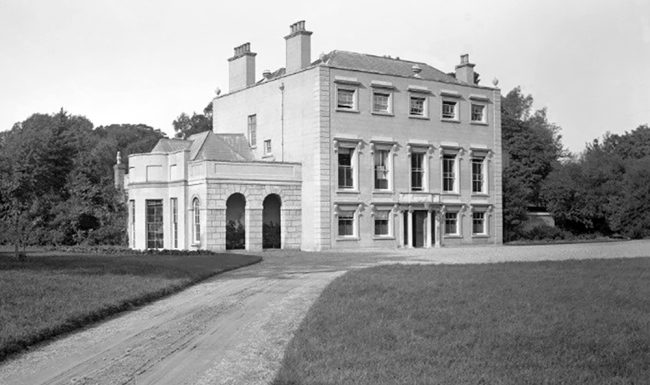
The house from a circa 1890 postcard. This image is in the public domain.

The Casino Marino from a 1982 Irish stamp
House & Family History: During his nine-year Grand Tour Lord Charlemont, who was obsessed with all things Italian (his house was named after the town of Marino in Lazio), became friends with Giovanni Battista Piranesi, who, in 1756, dedicated the first edition of “Le Antichità Romane” to his Irish friend. Chambers designed an octagon room in the the right-hand-wing of Marino House to display Lord Charlemont's sculpture collection.
Collections: A printed cotton illustration made in Ireland in 1782 and entitled "The Provincial Review, Phoenix Park, Dublin: Lord Charlemont Escorted by Cavalry" is today in the collection of the Museum of Fine Arts, Boston. Julia Marciari Alexander, writing in "This Other Eden: Paintings from the Yale Center for British Art," says of Lord Charlemont: "he was an avid collector of ancient and modern works of art; through his patronage he greatly contributed to the understanding of Antiquity and, by extension, to the development of art and architecture in mid-to-late-eighteenth-century England and Ireland."
Comments: The Casino Marino is considered one of the finest Neoclassical buildings in Europe. Mark Bence-Jones called the Casino "...one of the most exquisite miniature 18th century buildings in Europe." Sir Sacheverell Sitwell compared the interior of the Casino to the little rooms in the Petit Trianon at Versailles. David Netto, writing in the March 30, 2012 edition of "The Wall Street Journal Magazine" on the Casino: "If there ever were a great flood, and only one building could be saved to show future generations the best of the Enlightenment, a good candidate would be the Casino at Marino."
Garden & Outbuildings: After he returned from his Grand Tour, Lord Charlemont decided to build a pleasure house (a folly) in the form of a Roman Doric temple on the grounds of the Marino Estate, which he called the Casino. Lord Charlemont, who probably considered this building his most important accomplishment, commissioned craftsmen of the highest quality in the creation of the folly, including Joseph Wilton and Simon Vierpyl. The name derives from the diminutive form of the 18th century Italian word “casa,” meaning little house (it never had any association with gambling). Originally linked to Marino House by a tunnel (today blocked off), the Casino is generally considered Ireland’s first and most important Neoclassical building. The Casino Marino was originally conceived as an end pavilion for Harewood House in Yorkshire that was never built. The folly cost Lord Charlemont the enormous sum of £60,000 to build (equivalent to approximately £103 million in 2016 inflation-adjusted values using the labour value commodity index). Measuring just 50 feet square, the building is in the form of a Greek Cross that appears, from the outside, to be a single-roomed structure. The reality, however, is that it has 16 rooms on three floors. The basement contains a kitchen and associated work rooms, the main floor features formal reception rooms, while the top floor has accommodation for servants and a state bedroom. The visual tricks don’t end there, however: four of the columns that surround the Casino are hollow and used as downspouts, while the Roman funerary urns on the roof are chimneys. In his travel guide of 1791, Charles T. Bowden described the grounds of Marino House as a “terrestrial paradise.”
Architect: James Gandon
Date: Probably 1770sArchitect: William Oldham Chambers
Date: 1758-76Country Life: Feb 4-11, 1988.
Title: Guide to Irish Country Houses, A
Author: Bence-Jones, Mark
Year Published: 1988
Reference: pg. 201
Publisher: London: Constable and Company
ISBN: 0094699909
Book Type: Hardback
Title: Biographical Dictionary of British Architects, 1600-1840, A - SOFTBACK
Author: Colvin, Howard
Year Published: 1995
Reference: pg. 239
Publisher: New Haven: Yale University Press
ISBN: 0300072074
Book Type: Softback
Title: This Other Eden: Paintings From the Yale Center for British Art
Author: Warner, Malcolm; Alexander, Julia Marciari
Year Published: 1998
Reference: pg. 92
Publisher: New Haven: Yale University Press
ISBN: 0300074980
Book Type: Hardback
Title: Great Irish Houses and Castles
Author: O'Brien, Jacqueline; Guinness, Desmond
Year Published: 1992
Reference: pg. 108
Publisher: New York: Harry N. Abrams, Inc.
ISBN: 0810933659
Book Type: Hardback
House Listed: Demolished
Park Listed: Unknown
Past Seat / Home of: James Caulfeild, 1st Earl of Charlemont, 1755-99.
Current Ownership Type: Office of Public Works
Primary Current Ownership Use: Visitor Attraction
House Open to Public: Folly / Outbuildings Only
Phone: 18-331-618
Fax: 18-332-636
Email: [email protected]
Website: https://www.heritageireland.ie
Historic Houses Member: No